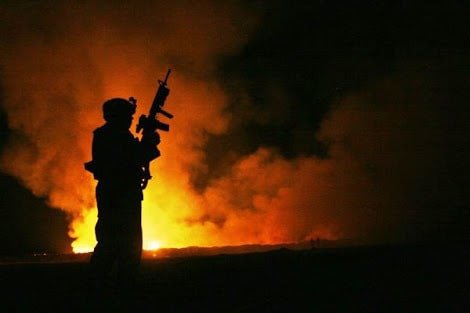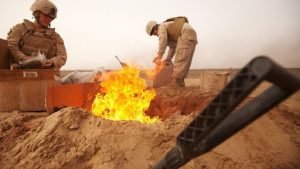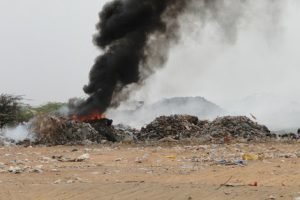
“Burn Pits” Allegedly Claimed Another Life

In a rather saddening incident, a National Guard veteran, Amie Muller, died after 9 months of struggle against stage III pancreatic cancer. Before moving to Minnesota Amie was posted in Iraq and the nature of her job forced her to live and work at an airbase in the north of Iraq, which had several so-called “burn pits”, billowing toxic gasses every second.
Amie, a mother of three, told her story to the Star Tribune soon after she was diagnosed. Her frustration was evident in the way she explained the difficulties she had to experience during her chemotherapy sessions and the side effects of related medical procedures. However, her major concern was for others who were still not aware of the dangers of living near the burn pits.
In a memorial service held in Woodbury, Pastor Lisa Renlund expressed her pain over the sad demise of Muller. People are also remembering the efforts Muller was putting for the US government to recognize the victims of burn pits, which have the potential to become this war’s Agent Orange, the notorious chemical of the Vietnam war.
Brutal truth of Balad’s Burn pit

Muller was posted to Balad, an Iraqi city, with the Minnesota Air National Guard in 2005 as well as in 2007. Her living quarters were close to one of the notorious burn pits. Without taking the possible side effects into account, items such as Styrofoam, metals, plastics, electrical equipment and even human remains were cremated within the pits, using jet fuel to stoke the flames.
The burn pit was operated non-stop. According to estimates, waste in the amount of around 100 to 200 tons per day was consumed. The 25.000 troops who lived there, were under the continuous cover of the hazardous fumes emanating from the burn pit.
When Muller came back, she found herself tiring easily and suspected a whole host of medical issues that could cause her problems. But she would have never imagined that what she had brought with her from Balad was cancer, which she was diagnosed with in May 2016.
Muller was not the only one who suffered. Julie Tomaska, who served alongside Muller at the same time, also suffered from headaches, fatigue, and digestive problems. Her claim with the VA was approved for unspecified “environmental exposure”. Tomaska and Muller became close after Muller’s diagnosis, and she not only helped her with the paperwork involved for her disability claims but also went with her for treatments at the Mayo clinic.
Tomaska now aims to set up a foundation for others like Amie.
Rising Trend of Veterans Coming Home With Health Issues

Though the Department of Veteran’s Affairs stands by the research claims that there is no definitive proof of long-term health concerns caused by burn pits, service members who were stationed near one have created a registry which now includes 100,000 people.
There have been a few positive moves. One such step was taken in 2017, when bipartisan legislation was introduced by Sens. Thom Tillis, R-N.C., and Amy Klobuchar, D-Minn. It seeks to promote understanding of the health effects caused by burn pits. It will also provide treatment opportunities to veterans.
As Klobuchar praises the efforts done at Minneapolis VA she also says “What’s important to me is that we keep doing this research and we don’t close our eyes and pretend that it’s just a coincidence that these veterans came home with these illnesses.” Comparing this with agent Orange and gulf war syndrome She emphasized “It’s a sad chapter, whether it was Agent Orange or Gulf War Syndrome, that people had to wait this long. We don’t want this to happen again with burn pits.”
The author of “The Burn Pits: The Poisoning of America’s Soldiers”, Joseph Hickman, who also happens to be a veteran, expresses his concerns over the delay in claims of Veterans.
Last Goodbye to Muller
During the service in Muller’s memory, honor guards and other mourners said their last goodbye to Muller. The memorial took place at Crossroads Church in Woodbury and despite the growing snowstorm, the Patriot Guard who stood outside were not deterred.
Photos from Mueller’s journey through life were shown, including family trips to the Caribbean and snaps from her military training or her deployments.
Retired Lt. Col. Audra Flanagan talked about Muller and noted that her training was in military photojournalism. Her accomplishments included making video and photo records for the families of fallen service members as an honor to their service. She was also a great graphic artist and designed a special license plate for those who had lost a spouse or a child in active duty.
Flanagan said, “No one could have honored our fallen service members with the same heart and grace as Amie,”.
The burial of Muller took place at Fort Snelling National Cemetery.
More inOpen Your Mind
-
`
What to Expect From Qatar Airways Business Class
Qatar Airways business class offers a luxurious experience for those seeking a comfortable and stylish flight. Travelers can expect a journey...
September 25, 2024 -
`
How to Deal with Gaslighting: 6 Effective Ways
Gaslighting is a manipulative tactic used to make a person doubt their own reality, memories, or perceptions. It can occur in...
September 21, 2024 -
`
Top 5 Things to Do in the Big Apple
New York City, often hailed as the “City That Never Sleeps,” offers an endless array of experiences. From towering skyscrapers to...
September 11, 2024 -
`
Easy-to-Follow Steps to Make Pappardelle Pasta at Home
Making pappardelle pasta at home is a rewarding culinary experience that brings the taste of Italy into your kitchen. Pappardelle, a...
September 5, 2024 -
`
How Legally Binding Is a Lease?
How legally binding is a lease? Understanding how legally binding a lease is becomes crucial for landlords when considering rental agreements....
August 31, 2024 -
`
Top 5 Must-Try Dunkin’ Donuts Breakfast Foods
When you are on the go and need a quick yet satisfying breakfast, Dunkin’ Donuts is a favorite stop for many....
August 21, 2024 -
`
What Are the Top 6 Best Places to Raise Children in the U.S?
Choosing where to settle down and raise a family is one of the most significant decisions parents can make. Finding the...
August 17, 2024 -
`
Is Wearing a Hoodie a Sign of Depression?
Is wearing a hoodie a sign of depression? This question has crossed the minds of many concerned parents and friends. It...
August 9, 2024 -
`
Top 6 Things You Should Consider Buying When You Are in Japan
Traditional Japanese Tea Sets When thinking about what to buy in Japan, traditional Japanese tea sets top the list. These beautifully...
July 31, 2024















You must be logged in to post a comment Login